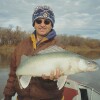North Dakota pheasant numbers are down from last year, while sharp-tailed grouse and gray partridge numbers are about the same, the Game and Fish Department said Thursday, Sept. 9, in reporting results from annual roadside surveys conducted in late July and August.
The results of the annual upland late summer counts were expected, given the widespread dry conditions, said Jesse Kolar, upland game supervisor for Game and Fish in Dickinson, N.D.
RELATED STORIES:
- Read more hunting stories in Northland Outdoors
- Read more fishing stories in Northland Outdoors
- Read more recreation stories in Northland Outdoors
“Recent weather patterns have shifted toward a drier period, particularly this year with a warm, open winter and exceptional drought across much of the state,” Kolar said. “Hunters should expect to find similar numbers to 2020, with the exception that there will be fewer acres of typical grassland cover to walk.”
ADVERTISEMENT

The survey tallied an average of 45 pheasants per 100 miles, down 23% from last year, and five broods per 100 miles, down 30%, the department said. The average brood pheasant brood size remained unchanged at six.
The final summary is based on 266 survey runs made along 102 brood routes across North Dakota.
Here’s a look at pheasant counts by region:
Northwest: Observers counted eight broods and 68 pheasants per 100 miles, down from 10 broods and 80 pheasants in 2020. Average brood size was six.
Southeast: Results showed three broods and 24 pheasants per 100 miles, down from five broods and 42 pheasants in 2020. Average brood size was four.
Southwest: The survey tallied six broods and 59 pheasants per 100 miles, down from seven broods and 65 pheasants in 2020. Average brood size was seven chicks.
The northeast district, generally containing secondary pheasant habitat with lower pheasant numbers compared with the rest of the state, showed three broods and 24 pheasants per 100 miles, compared with three broods and 22 pheasants last year. Average brood size was five.
Sharptail and partridge seasons open Saturday, Sept. 11, and sharptail hunters should expect to find mainly adult grouse this fall, Kolar said. He said numbers along the Missouri River are still high compared to long-term averages, so hunters who can find cover should have average to good hunting. The eastern part of the state has fewer sharp-tailed grouse, with isolated hot spots.
“Many rangelands that hold grouse on an average year will be too open to hunt this fall, and most grouse will likely be found in shrubland and woodland draws and/or near riparian areas,” Kolar said.
Sharptails observed per 100 miles are up 2% statewide. Brood survey results show observers recorded two sharptail broods and 19 sharptails per 100 miles, with an average brood size of six.
ADVERTISEMENT
Although partridge numbers have shown a slight increase, Kolar said most of the partridge harvest is incidental while hunters pursue grouse or pheasants. Partridge densities in general, he said, are too low to target.
Partridge observed per 100 miles are up 9%. Observers recorded one partridge brood and 10 partridge per 100 miles. Average brood size was 10.
North Dakota’s pheasant season opens Saturday, Oct. 9, and continues through Jan. 2, 2022. The two-day youth pheasant hunting weekend, when legally licensed residents and nonresidents 15 and younger can hunt statewide, is set for Oct. 2-3.
Grouse and partridge seasons also continue through Jan. 2.
Last year, an estimated 57,141 pheasant hunters went afield, up 14% from 2019, and they shot 330,668 roosters, an increase of 28% from 2019, the Game and Fish Department reported in August. Sharptail and partridge success in 2020 also was up from the previous year, the Game and Fish Department said.









